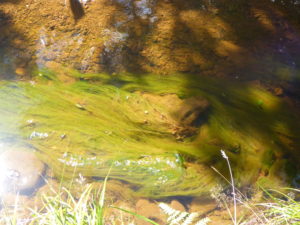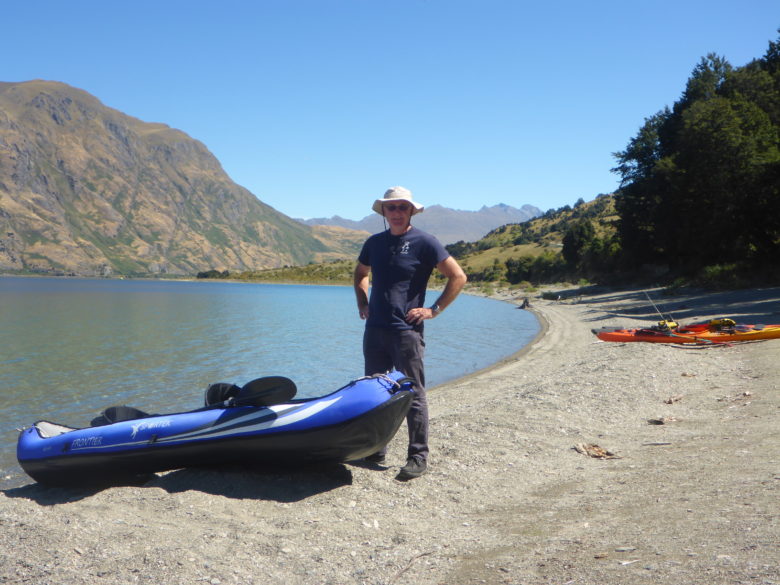Captain James Cook was doubtful as to whether he and his crew would be able to sail their exploration ship, Endeavour, back out of the sound named after his reservations, which is in fact a fjord since it was ground out by a glacier. Don’t you agree, Doubtful Sound sits more comfortably on the ear than Doubtful Fiord?
It certainly sits comfortably on the eye; after a day voyaging through the south west area to Manapouri we were tired from an excess of magnificence, this truly was NZ in its most remote and raw beauty that transcended the ages as Venus transcends the night sky. We stretched our legs along the shores of Manapouri Lake in the afternoon sunshine.
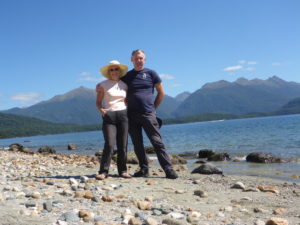

Rob and I chatted with a retired NZ sheep farmer and his young springer spaniel Buster, a young Toby lookalike, as we waited to board our ferry. He had a boat, a little cabin cruiser moored nearby and was determined to spend some time refitting it so he could take his family onto the lake at weekends. When New Zealanders get time off they get afloat.
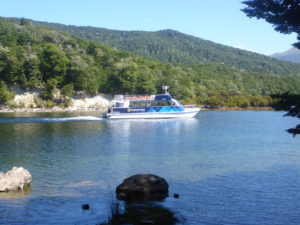
The first part of our day’s adventure took us in a fast boat across Lake Manapouri on one of the 65 cloudless days this area gets every year. You won’t see our guide anymore, selling Melton Mowbray raised pork pies in the town the pies were named after and at Oakham’s Saturday Market because he is here now, telling us what he knows about the area in his short time here. When he waved his hand broadly across the vista and said “Look up there, there must be some of that expanse that has never seen a man.” Most of that expanse has never been trodden with human foot is more likely, I thought.
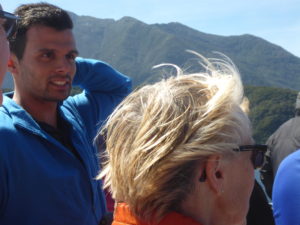
At the start most of us arrived in dribs and drabs, parking our cars or descending from buses, but one full, big coachload of Chinese arrived and comprised 50% of our group. They were all Chinese and no Japanese because I asked their female guide and she told me the Japanese went to Milford Sound.
I will tell you at the outset what saddens me about these, nouveau riche and recently released to travel Chinese, and that is they move around in an insulated bubble and even if they can speak English they make no attempt and seem not to want to communicate with anyone else. I tried catching their eyes as a prelude to some sort of chat, even with gesticulation, but they would look away. So I wondered what they wanted to get out of their travels.
Certainly they will go home with not hundreds but thousands of photos, all containing themselves with a scenic or civic backdrop and no doubt a few ‘made in China’ trinkets, but that seemed a bit shallow and lacklustre to me.
What really made my trip to China 16 years ago a real pleasure was the Chinese people in their home country. Where ever we went they were interested in us and most of them spoke English and even if they didn’t we could make ourselves understood, often with shared humour thrown in. So sad.
We berthed next to a hydro-electric plant where the water falls 183 metres to create power for the massive aluminium smelting plant at Bluff. Relaxing New Zealanders are often found in their little aluminium boats called ‘tinnies’ the fabric of which is smelted at Bluff. As part of the pay back for the encroachment on the land the company had built a gravel road right across the mountainous land to the Sound which was open for public use.
The Chinese in their coach and the rest of us in ours sped up and down, passing trekkers with their backpacks. The hills are very steep and the coaches are fitted with retarders to assist the brakes. Locals bring their cars and boats across from Manapouri on a barge, drive the road and re-launch for a day on the Sound.
We crunched into a lookout space above Deep Cove and descended the coach for our first elevated ‘wow’ view of the water, flat and glistening blue far below us, contained by steep, almost vertical rock faces covered in trees. The atmosphere was crisp and pure once the dust of our arrival had cleared.
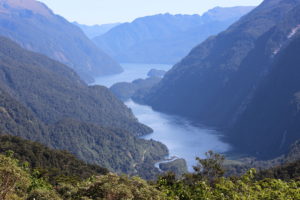
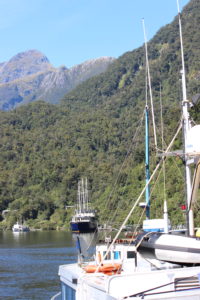
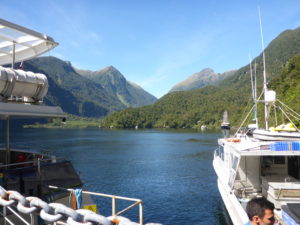
The peaks, rugged and irregular, towered above us in clear definition as we left a fantail of white wash in the ridiculously blue water. We met a couple, Ian and Heather, from Haywards Heath in the UK and enjoyed the cruise together. As we parted at the end I said with confidence, “We will meet you again, this is NZ” They thought I was a little crazy I know.
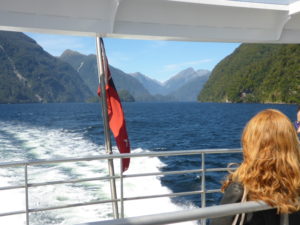
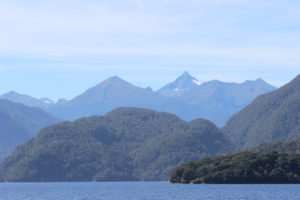
The Captain, sitting on his high swivel chair, joystick controls in hand and accessible for our questions behind a partial clear screen, would come over the tannoy and alert us to some point of interest, for example the four Crested Fjord Penguins languishing in the water and clearly chatting and the many fur seals on the rocks snoozing or mock fighting. He put the vessel within stinky breath range of those seals, now burgeoning in numbers as their hunting has been banned for years.
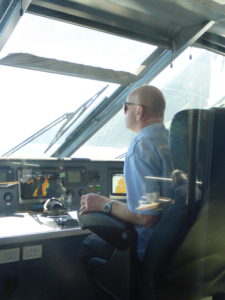
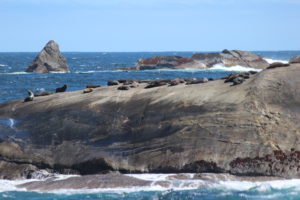
After a few minutes of time out on the unusually calm Tasman Sea we turned back toward the view of the Sound that Cook must have regretted having to pass unexplored. Our little vessel motored into one of the elbows that lead off the main track of water and we pointed directly towards snow-capped mounts.
Captain turned off the engines and we stood in almost complete silence, one of our oriental friends was late understanding the message, then there was no sound, just the awe of natural greatness, a soaring mollyhawk catching the thermals and sometimes for others but not us on this occasion, the eerie cry of rutting moose and red deer. We were there in our tiny boat with permission from the wonderful scenery around us for this millionth of a second on the time scale of creation, united in admiration.
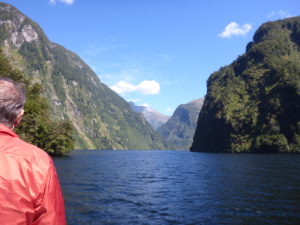

On the way back our guide pointed to a valley where two ancient glaciers joined that had been a Peter Jackson wannabe for scenes in the Lord of The Rings, but on the day the valley turned shy and hid in mist and rain so Sir Peter had to revert to plan B.
The overnight ship passed us on its way out sporting its three characteristic masts. Booked up until three weeks after we planned to have left the area so we couldn’t do that trip, we were told that our day trip was the best value as early mornings can often be foggy and cloudy anyway. We did fancy the idea of listening to night sounds and taking in the Sound for 24 hours but never mind.
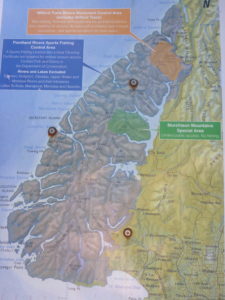
Back at our quirky little camp we studied the family photos over the years. They told the story of a husband and wife who set up the camp as a business and a place to indulge a love of old vehicles, especially but not exclusively Morris Minors and their cousins, Morris 1000s. They had all been driven to the site and maintained until the father died. Another family photo showed the whole family and clearly the oldest of the three children now runs the camp and does not share his father’s passion. The vehicles are rotting where they stand.
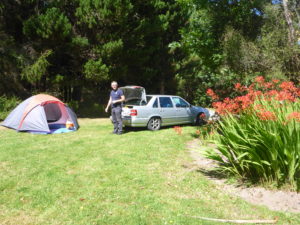
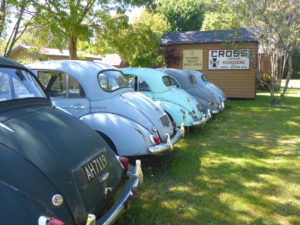
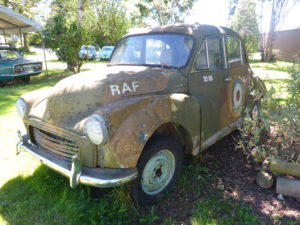
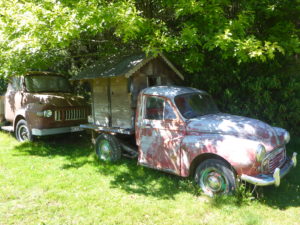
It’s a lovely place to camp and much of the structure, including the different styled ‘house’ accommodations and the fitted out kitchen and dining room is all made on site and quite unique. The weather while we were there was quiet, warm and sunny and the cicadas had a field day, and we slept well, tired from the aesthetic quality or our adventure.
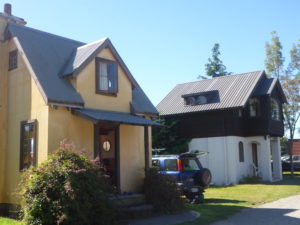
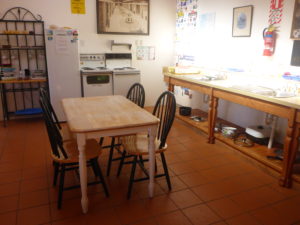
Blue Lakes and Mountain Scars – 40 hours in the wilderness
We were on the road again, joining Highway 6 at Five Rivers, thick and orange on the map and then onto the Cardrona Ski Road, through the Pisa Mountain Range, a thin yellow line on the map that the road side sign told us was OPEN.
We crossed the Oreti River that meets the sea near Invercargill where Vicky took her beach stroll. I couldn’t reason then the name of one farmstead, Five Rivers, with the fact the numerous rivers we drove over were almost dry and the farm was irrigating the grass. Shortage of rain or too much irrigation or both I wondered. NZ exports much dairy produce to China and is now facing competition from South America who is also exporting big time to the Orient. When will the quest to maintain exports from marginal land become unviable?
(June 2018 Micro Plasma Bovis is now rampaging through the dairy herds of the Southlands and 150,000 cows are due to be sent to the meat works over the next few years. Therein lies some of the answer.)
Small town Garston has seen the changes over the years. Gold was discovered here and 65,000oz of alluvial gold was panned, but those days are long gone and now ski-ing and farming are the main industries. We were entering another Lake District and the first we came to was Lake Wakatipu. It was time for elevenses so we found our way to a lake head car park down Churchill Road and soaked up the exquisite beauty of the glistening lake under the cloudless sky. The neat homes could be for retirement, Airbnb investments or second homes but many were family homes in this pristine part of Central Southland.
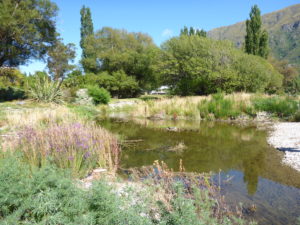
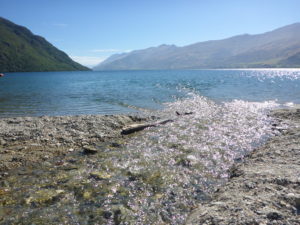
![]()
Back on the road the Eyre Mountains loomed alongside and places along the road showed where landslides had been cleaned up. There is so little soil the trees lock their roots together to cling onto the sheer rock walls, relying on moss and lichen for nutrients, nature’s own hydroponics.
With the weight of heavy rain or snow ‘tree avalanches’ are a common occurrence and when one tumbles at the top it brings down dozens of others in a domino effect leaving an ugly brown scar on the hillside. Lichen and moss soon cover the scar and the re-growth begins.
We arrived at the end of the Southern Scenic Route and were now on the Gold Heritage Route. This was an area of plenty where a lavish life style could be enjoyed. Vast deer farms and deer hunting abound, golf courses, water sports, every driveway contained a small aluminium boat, a born at Bluff tinny. Spa Resorts, ski-ing, vineyards all amidst mountains rising to 2400 metres.
The main town is Queenstown and it is the hub of tourist activity in the area with numerous other towns taking spin off business. It is very busy and attracts people who want to see NZ via the thrills of short time adventures. We gave it a miss, Zoonie gives us plenty of adventures.
But we did see the spectacular flight path that planes use to land at the airport. Vicky had just climbed the steep zig zag Cardrona Valley Road to 1936 metres and needed a break to cool down and get her breath back. So while she hissed and whirred we watched jet planes coming over the pass to see the Queenstown area and runway ahead. Fields of Barley swayed in the breeze and 19’ of warmth helped the ripening.

![]()
The Gin and Raspberries Gold Company of Cardrona had found a gold nugget in the Motukituki River leading to a gold rush. The town swelled from hundreds to thousands and thrived for a short time, then with the end of the boom times it became a backwater until the ski-industry moved in and gave it a seasonal reprieve, a new rush of thrill seakers.
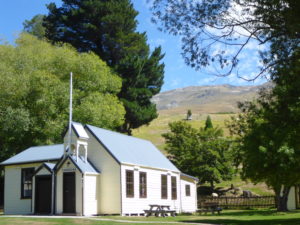
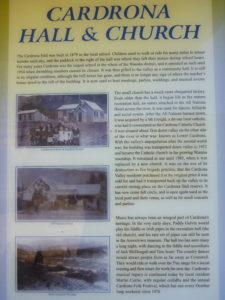
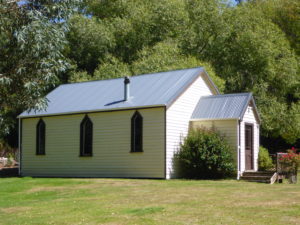
The restful atmosphere we had so enjoyed in the Fiords was all gone as the press of frenzied tourism was everywhere. Snow-capped and glaciated Mount Aspiring at 3000 metres was staring us in the face at Wanaka where we had thought we might spend the night.
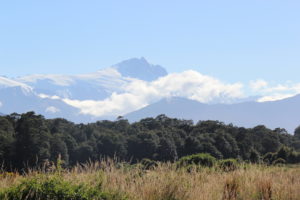 Oh no, Wanaka was way too busy for us. We grabbed an ice cream and got back in the car. “I’ll just top up with fuel,” Rob said,
Oh no, Wanaka was way too busy for us. We grabbed an ice cream and got back in the car. “I’ll just top up with fuel,” Rob said,
“You what, not at $2.9 per litre you won’t, my love” I reasoned, “We’ve still got half a tank, that’ll get us to the coast if we off gas downhill, remember La Gomera,” where we coasted downhill for 21kms.
This area is burgeoning with new housing estates going up everywhere quicker than bamboo huts. Housing development, the tourism rush, how long will this one last? We were out of there; nowhere else on the South Island had we seen such change, not even in Christchurch.
Phew, back into a Scotland lookalike, The Southern Alps. Lakewater as smooth as a fur seal’s pelt, vast breathtaking mountains; we were on the windy road along the shore of Lake Hawea and before crossing the bridge that joins it to Lake Wanaka we turned right along a dusty track over private land to Kidds Bush Camp Site run by the DOC. It was on the shore of Lake Hawea and we had seen it from the road.
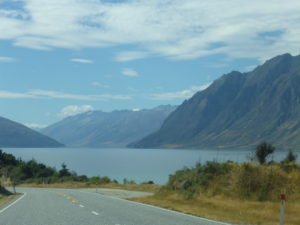
Soon our little tent was pitched right on the bank above the water’s edge and peace enveloped us. OK the sand flies were a bit if a pain but we would be staying here a while.
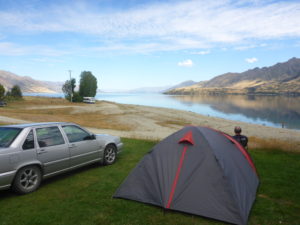
Forty hours in the wilderness.
The next morning dawned cool but beautiful once again and as soon as the sun rose above the mountain beech line on the far hills it drove away the shadows and the day started to warm up.
I was curious to see what was around the headland so we launched the inflatable kayak and paddled off from the shore. No biting bugs on the water so that was a relief. Trampers walked along the shore in the same direction we were paddling and as we slid around the corner we found more of the same, beautiful lake and mountains bathed in sunlight.
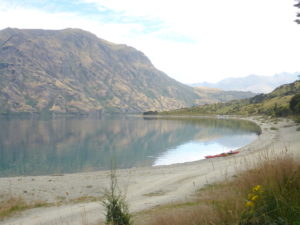
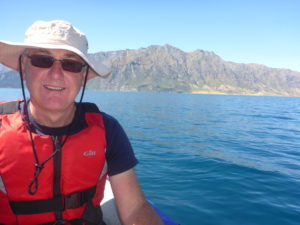

Back at camp a mature gentleman from a campervan told us he used to farm near here and this weather was very unusual. He had seen gale force winds build up a frightening fetch along the length of the lake and whisk campers’ tables and sunbrellas up into the hillside never to be seen again.
After a lunch of Vicky ripened avocados and salad I went for a swim, the lake water was saying “swim in me”, so I did. It was cool and delicious. The retired couple who had just started as volunteers in the camp told us that a fortnight ago a film unit starring Reece Witherspoon, of Walk the Line fame amongst many others, was here filming ‘Wrinkles in Time’. So we’ll keep our eyes open for that one.
As an interesting aside, later in the afternoon a flock of hundreds of sheep was driven down the track by the camp. Well that caused a stir and we all watched as dogs ran all over the place including along the sheeps’ backs to keep them in order. The dust they created was something. Whenever a vehicle started onto our 6km track we could watch its progress behind the rises just by the dust trail.
We went to sleep to the sounds of late returning motorboats, cicadas working overtime and lapping waves. Around 2.00am I awoke to hear the NZ long tailed cuckoo calling. Eventually another one replied, its call sometimes overlapping the other.
The Haast Pass was a very modest affair and Vicky creamed up and over the slight elevation towards the Tasman coast, out of our own personal wilderness and into Westland. The construction of the Haast Highway along the coast was started back in the 1920s and 30s by using unemployed labour. The hardest sections were blasted out after the Second World War and the brick ammunition huts can still be seen. Finally the magnificent West Coast Highway was opened in 1960.
We were on our way to Fox Glacier, a town named after the glacier, but on route we stopped just over the Moeraki River for a lovely woodlands walk down to the Monro Beach where the Fjord Crested Penguins are known to come ashore and breed. Fortunately there were no penguins on the beach to disturb, just sand flies that shortened our stay.
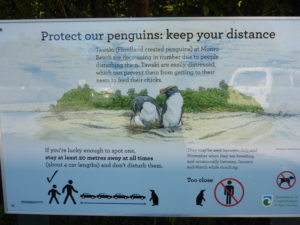
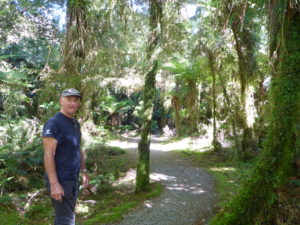
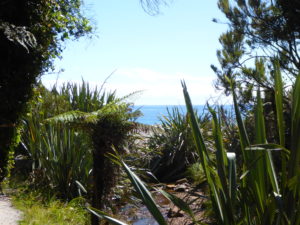
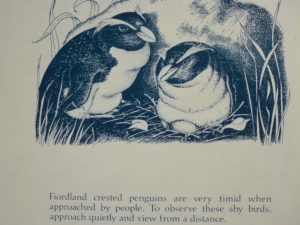
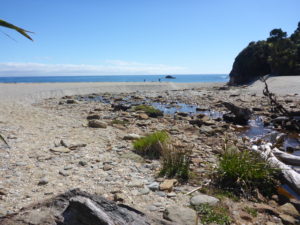
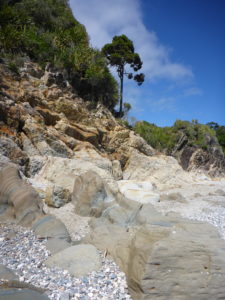
![]()
On our way back through the woods and over the numerous streams and boggy bits Rob and I wondered why the beach is opened up for visitors when the DOC reports that disturbing the penguins when they are nursing their young is causing their numbers to decrease. If they want to protect them surely they need to control access to the beach during breeding times.
